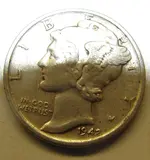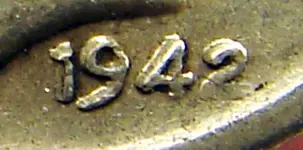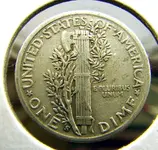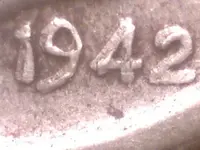Some thing I found doing a google search...
List of the Key Dates in the Mercury Dime Series
The key dates in the Mercury Dime series are as follows:
1916-D - With a mintage of only 264,000 this is by far the rarest Mercury key
1942/1 (2 over 1 date) - Overdate type for both 1942 and 1942-D, mintages are unknown but the type is extremely rare
Semi-key (scarce) dates in the Mercury Dime series include:
1921
1921-D
1926-S
1931-S
1931-S
.........................
My dear old dad found one in some change and SWEARS it is a 1933 Mercury Dime.. there where none printed in that date..Sorry hit send before I was done.. here is another artical about that year dime and double dies....In MY oppion it looks like the date is doubled, HOWEVER, I seem to need glass's latly...HAHA!
Enjoy and good luck in finding out if the coin world takes it as a double...
Collecting Mercury Dimes
At the outset of coinage, a rarity was created: the 1916 Denver Mint Mercury dime. Only 264,000 of these were struck. It is often the case that the first year of issue of anything is saved in quantity by the public. Witness the 1909 V.D.B. Lincoln cents and 1883 Liberty Head nickels as examples. Not so with the 1916-D dime. This issue slipped through the cracks, figuratively speaking, and was rare from the outset.
Other rare issues in the Mercury dime series include the 1921 dimes of both the Denver and Philadelphia mints. Minted during a recession year (although the recession term had not been admitted into the halls of economic commentary at that time), production quantities of both dimes were low.
Two overdates occur among Mercury dimes, the 1942/1 and the 1942/1-D. Both are scarce, and in Mint State each is a notable rarity.
Examples of the Mercury dime type are readily available in all grades from About Good through superb Uncirculated. Certain issues are lightly struck and are apt to have weaknesses on the bands tying the sticks in the fasces on the reverse. Those with sharply defined bands, designated as "full split bands" (abbreviated FSB) are often worth more.
An interesting situation is provided by the 1945 Philadelphia Mint dime. In MS-65 grade, this is one of the most common issues of the entire series. Many thousands exist. However, with full split bands on the reverse it is a major rarity. No more than a few dozen have ever come on the market!
Proofs of the 1936 through 1942 years are available in proportion to their mintages, with 1936 being the rarest. Many collectors have made sets of these comprising the seven different dates.
"TR"







 It also shows the "clam" effect on the numbers too
It also shows the "clam" effect on the numbers too 


